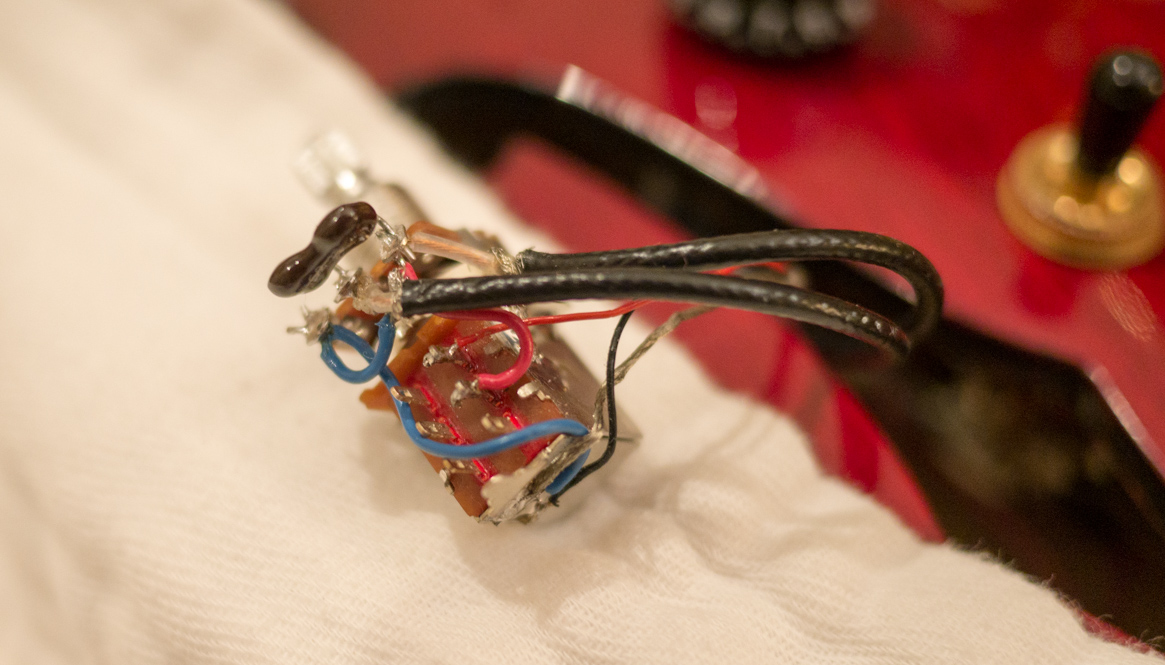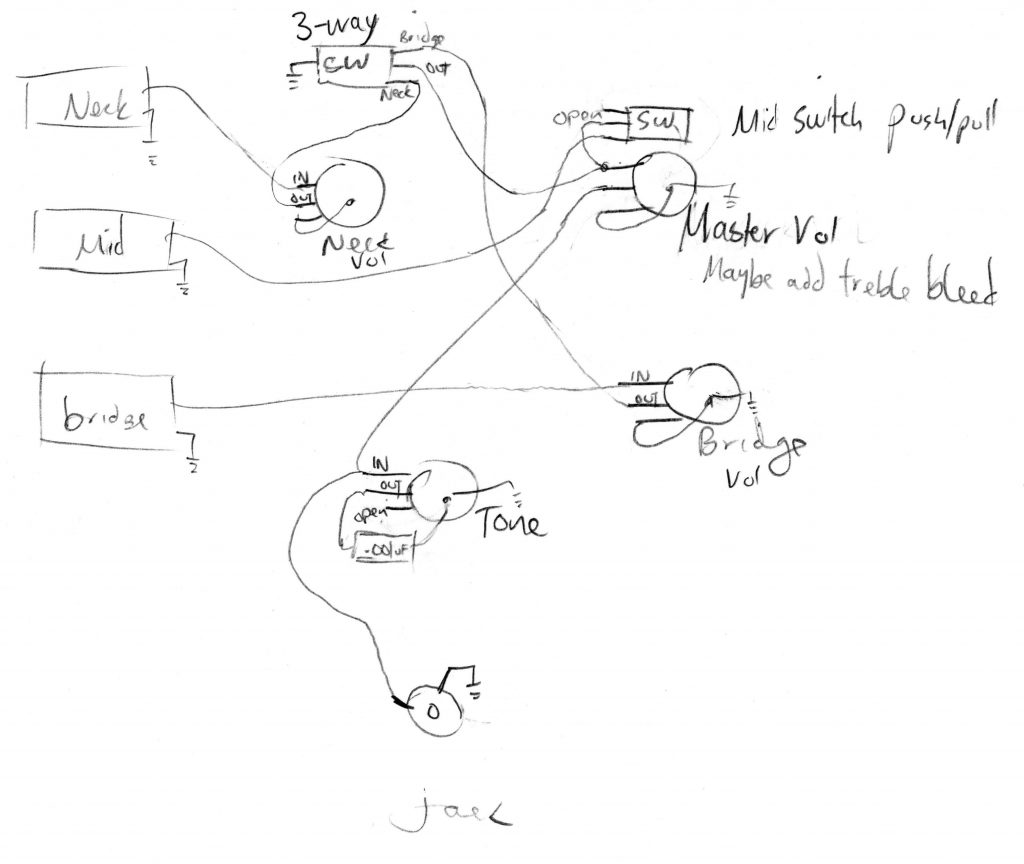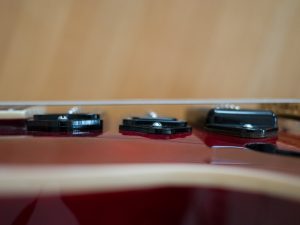Riviera P-93 Middle Pickup Mods
I’ve written before about the circuit challenges on the Epiphone Riviera P-93 – treble loss when turning down the volume, no way to use treble bleed caps, and the awkward always-on middle pickup.
The Riviera P-93 has 3 pickups, a 3-way switch and 3 volume knobs. The middle pickup is always on, and the only way to silence it is to turn its volume knob all the way down. This approach requires the use of independent volume wiring (to avoid silencing all the pickups when turning down one of them). With independent volume (aka decoupled) wiring, the pickup signal is wired to the center pot lug and the output is on the side lug. The problem with this is that the load on the pickup increases as you turn the volume down, which results in significant treble loss and a dull sound as you turn down.
Remember, this issue can be a avoided on a typical two pickup 3-way switch guitar (Les Paul, ES-335, Sheraton, etc) because on those, with only two pickups, the 3-way switch has two non-blending positions which completely isolate a pickup. So instead of using the independent-volume-wiring (pickup signal wired to center volume pot lug), you can use non-independent (coupled) volume-wiring (pickup signal wiring to side pot lug). In that configuration, there is no treble loss when turning down the volume, but if you turn down the volume all the way, it also kills the volume for the other pickup. (Hence the “non-independent” in the name). But this isn’t a problem because with only two pickups, if you want to turn off one of the pickups, you can just use the 3-way switch – you’ll never need to turn a volume pot all the way down.
In my 2011 article, I listed a bunch of possible options for reconfiguring the controls and electronics on this Riviera P93. I settled on this idea:
Another option occurred to me. This is a variation on #1,2 and 7. Replace the middle volume pot with a push/pull pot. Make this a master volume control with treble bleed, and make the push/pull enable/disable the middle pickup.
So I finally got around to trying it, and it works pretty well. Here’s a quick-and-dirty diagram:
In this circuit, I’m using the push/pull’s potentiometer as a master volume, and I’m using one side of the DPDT switch as a kill-switch for the middle pickup. For more on push/pull pots, see my previous article on the subject.
When engaged, the push/pull switch simply sums the middle pickup with the output from the 3-way switch. The 3-way switch acts just like a 2-pickup guitar (neck, neck+bridge, bridge), and the middle pickup is engaged on/off by the push/pull with no separate volume control.
This configuration allows me to use the typical Gibson 2-pickup 3-way-switch non-independent volume wiring (pickup signal wired to side lug, output on center lug). This maintains a constant minimal load on the pickup when turning the volume down, and minimizes treble loss. And if you want it to be even brighter/thinner when turning down, just add a treble bleed cap on the master.
While I was at it, I also lowered the middle pickup by replacing the spacer. I found that my pick tended to hit the middle pickup when strumming. And since I’ll mostly use the middle pickup as an add-on to one of the other pickups to buck hum, it should be ok at a lower position.



October 24, 2017 @ 4:43 pm
Great write up! This configuration looks quite effective. Thank you so much for posting this (so quickly too, I might add!).
October 24, 2017 @ 7:02 pm
Thanks Craig. Let me know what you end up doing with your P-93!
November 30, 2017 @ 11:08 am
John – I ended up going in a bit of a different direction. I installed a 5-way rotary switch with a black chicken-head knob (I really like the look of it). I wired the guitar up with three tone pots and a master volume. The 5-way does Strat-style pickup selecting, which allows me to isolate the P90s, and add the middle in for hum cancelling if I wish. Although there isn’t a huge tone difference when the middle pickup is on by itself, I really like this setup. I went with CTS 500k pots and a Switchcraft jack while I was in there, for future reliability!
December 1, 2017 @ 12:20 pm
Cool! Good job, Craig.
Ideas for Treble Bleed Problems – Planet Z
October 25, 2017 @ 11:20 am
[…] Update 10/24/2017: That idea worked out well! I finally wrote up the new circuit here. […]
March 26, 2018 @ 10:34 am
Thanks for the write-ups, thought processes and diagrams on the P-93 wiring. I’m going to do this one. I’m about to order the parts. Which caps(s) did you end up using?
March 26, 2018 @ 12:34 pm
I used a silver mica cap for the treble bleed as you can see in that picture. I don’t remember exactly but it was probably around 330pf. And for the tone cap, I used an orange drop, which was actually a little large – difficult to fit through the f-hole. Experiment with alligator leads to find what you like!
-John
June 16, 2018 @ 5:12 pm
I forgot to report back and let you know that this wiring scheme turned out to be nice. My P93 is no longer useless.
June 18, 2018 @ 9:15 am
Great to hear, Roy! Thanks for following up.
-John
Sayonara Riviera – Planet Z
May 7, 2018 @ 10:02 am
[…] I purchased this guitar in July 2009. I had always wanted a semi-hollowbody like an ES-335 or a Sheraton, and I was seduced by the Riviera’s sexy curves, the lovely wine red finish, the Bigsby and the low price. Somehow I failed to take into consideration the pickups and flawed control scheme. By September, the honeymoon was over, the return period was expired, and I was looking to make changes. I was frustrated by the dull sound, and the 3 volume 1 tone control scheme had some significant limitations. […]
June 16, 2018 @ 5:38 am
Would not just a diode placed in line between the neck and the join with the mid effectively make the neck output a one way street and therefore not allow the mid signal to bleed to the cap?
June 16, 2018 @ 2:23 pm
Hi Aki- thanks for the message. A diode would cause clipping/distortion. See my faq: https://www.planetz.com/faq/#wiring
A Bloody Mess – Planet Z
December 1, 2018 @ 12:52 pm
[…] Update Feb 4, 2011: I wrote up a number of ideas for solutions in this blog post. And I wrote up my final mods in this post. […]
October 1, 2024 @ 10:50 am
Hi!
First off,thank you for sharing those informations !
I was wondering if I could ask some questions.
I’m curious about how you lower your mid pickup,I have the same problem!
DId you swaped the original pickup to use some kind of rings with soapbar p90 pickups or something?
Thank you !!